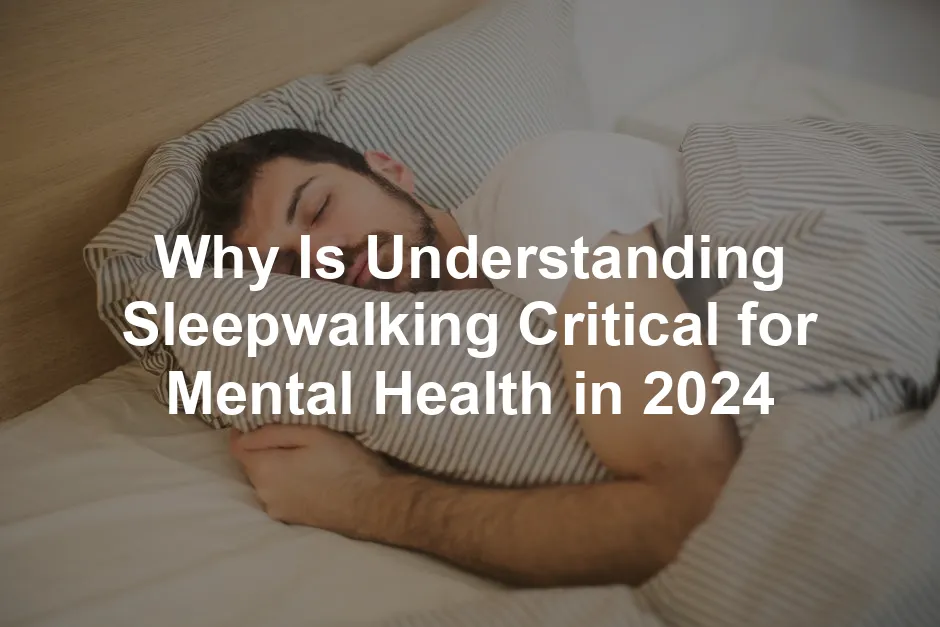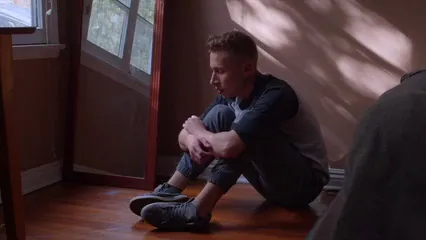
Why Is Understanding Sleepwalking Critical for Mental Health in 2024
Why Is Understanding Sleepwalking Critical for Mental Health in 2024
Sleepwalking, or somnambulism, is that quirky behavior where someone wanders around while still snoozing. Imagine a sleep-deprived zombie, aimlessly shuffling through the house, probably searching for snacks instead of brains. Surprisingly, it’s not just a childhood oddity; around 5% to 15% of children and about 1% to 1.5% of adults experience this phenomenon.
But what’s the real kicker? Sleepwalking isn’t just a harmless midnight stroll. It’s intricately linked to mental health. Research shows that sleepwalking can signal deeper psychological issues like anxiety or depression. The connections are complex, like trying to untangle your headphones after they’ve been sitting in your pocket for a week. To help with those tangled thoughts, consider using a Sleep Sound Machine to create a calming environment that promotes restful sleep and helps in reducing nighttime anxiety.
As we step into 2024, the urgency to grasp these connections grows. With rising mental health concerns worldwide, understanding sleepwalking becomes a vital piece of the puzzle. Unpacking how our nighttime escapades affect our mental well-being could pave the way for better management strategies. Think of it as a nocturnal journey through one’s psyche—a quirky exploration that, if understood, may lead to improved mental health practices.
So, why should you pay attention? Recognizing sleepwalking as more than just a nuisance could help us address underlying mental health issues. In this article, we’ll uncover the nuances of sleepwalking, its prevalence, and its ties to mental health, aiming to spark a conversation that urges greater awareness and understanding in 2024.

Summary
In this blog post, we will explore the multifaceted world of sleepwalking. We’ll discuss its definition, prevalence, and the intriguing links to mental health. More than just an amusing anecdote, sleepwalking can serve as a symptom of underlying psychological distress, making it crucial to recognize and address these behaviors.
By shedding light on the connections between sleepwalking and mental health, we aim to highlight the importance of understanding this condition, promoting better management strategies. So, stay curious as we unravel how knowing more about sleepwalking might lead to healthier minds in 2024!
Understanding Sleepwalking
Sleepwalking, or somnambulism, is a fascinating yet concerning sleep disorder. It occurs when individuals perform complex behaviors while still asleep, often without any recollection of the actions. These episodes typically happen during deep non-REM sleep, particularly in the first few hours of slumber. Sleepwalkers can engage in activities ranging from walking and talking to even cooking or cleaning—talk about multitasking!
Statistics show that sleepwalking is especially common in children, with 1 in 5 experiencing it at some point. However, it is not confined to the young. Adults can be affected too, with approximately 1.5% reporting episodes. Genetics play a significant role, as those with a family history of sleepwalking are more likely to experience it themselves. To ensure a smoother sleep for everyone, consider investing in a Weighted Blanket that can provide comfort and reduce stress during sleep.
Moreover, sleepwalking can be influenced by various factors, including stress, sleep deprivation, and underlying mental health issues. Conditions such as anxiety, depression, and other mood disorders can exacerbate sleepwalking episodes. This interplay suggests a complex relationship between sleep behaviors and mental health, making it essential to understand the psychological dimensions of sleepwalking as we navigate the mental health landscape in 2024.

Understanding the psychological dimensions of sleepwalking is crucial for addressing mental health issues effectively. why are coping strategies essential for handling anxiety in daily life
Sleepwalking and Mental Health
The Psychological Connection
Sleepwalking is not just a quirky nighttime activity; it’s often tied to psychological factors. Stress, anxiety, and trauma can trigger episodes. Picture your mind processing a stressful day while you’re off gallivanting in your sleep! Research indicates that sleepwalking often accompanies mood disorders like depression and obsessive-compulsive disorder (OCD). For instance, one study found that individuals with depression were 3.5 times more likely to experience sleepwalking than their non-depressed counterparts. It’s like your brain decides to throw a party while you’re asleep, but instead of fun, it’s a chaotic blend of unresolved emotions.
Trauma, especially from childhood, can manifest as sleepwalking episodes. This behavior can serve as an escape mechanism. The mind might be trying to release pent-up emotions during sleep. Imagine a pressure cooker; if it doesn’t release steam, it may explode. Similarly, unresolved psychological tension may lead to sleepwalking, making it critical to understand these connections for mental health in 2024. You could also enhance your sleep environment with an Essential Oil Diffuser to create a calming atmosphere that can soothe your mind and help alleviate stress.
Sleepwalking as a Symptom
Sleepwalking shouldn’t be viewed as an isolated quirk. It often indicates deeper mental health issues. Many sleepwalkers feel shame or stigma surrounding their nighttime escapades. This shame can exacerbate feelings of anxiety or depression, leading to a challenging mental health spiral. It’s tough to deal with a disorder that makes you feel like a midnight fool, isn’t it?
When sleepwalking occurs, it’s essential to recognize it as a potential symptom of underlying conditions. For example, someone grappling with anxiety might experience sleepwalking as a nighttime manifestation of their daily stressors. This connection highlights the importance of addressing sleepwalking seriously, rather than dismissing it as just another odd behavior. To help with anxiety, consider trying Melatonin Gummies to promote relaxation and encourage a better night’s sleep.
Co-occurring Conditions
Sleepwalking often plays a duet with other mental health conditions. The interplay between sleepwalking and disorders like anxiety, depression, and PTSD complicates diagnosis and treatment. It’s like trying to untangle a ball of yarn—one thread pulls another, making it tricky to navigate.
Case studies reveal that individuals who sleepwalk frequently may also struggle with anxiety disorders. In these scenarios, sleepwalking can worsen daytime anxiety, creating a cycle of distress. For instance, a person battling OCD might find their sleepwalking episodes increase during particularly stressful periods. These overlapping conditions can cloud the clinical picture, making it crucial for healthcare providers to assess the full spectrum of symptoms.
One compelling example comes from a study examining sleepwalking in children with anxiety. Many of those children experienced sleepwalking episodes during high-stress periods, like exams or family upheavals. The findings suggest that addressing the anxiety could reduce sleepwalking episodes, highlighting the necessity for a holistic approach to treatment. To support this, consider using a Sleep Journal to track patterns and identify triggers.

Understanding sleepwalking as part of a broader mental health context is vital. It opens avenues for improved diagnosis and treatment options, leading to better mental health outcomes in 2024. Recognizing the psychological threads woven into sleepwalking can ultimately help individuals reclaim restful nights and healthier minds.
Social and Relational Effects
Sleepwalking can be a real party crasher, especially when it comes to social interactions and relationships. Imagine waking up to find your partner rearranging the furniture or trying to make a midnight snack—while still in la-la land! This bewildering behavior often leads to feelings of embarrassment and isolation.
Many sleepwalkers report that their episodes create tension at home. For instance, one sleepwalker, Sarah, shared how her husband once found her standing outside in pajamas, chatting with a neighbor at 2 a.m. “I was mortified when I found out,” she said, recalling the laughter turned awkward. Such incidents can strain relationships, as partners may feel anxious about their loved one’s safety during sleep. To help create a more peaceful home environment, consider using a Night Light Projector that can help both sleepwalkers and their partners feel more secure and relaxed during the night.
Moreover, social gatherings can become an anxious affair. Sleepwalkers might avoid sleepovers or trips for fear of public episodes. A testimonial from Tom, a chronic sleepwalker, highlights this: “I skipped my friend’s wedding because I didn’t want to wake up in the middle of the dance floor!” This fear of judgment can lead to withdrawal, intensifying feelings of loneliness.
The stigma surrounding sleepwalking can also exacerbate mental health issues. Many individuals feel misunderstood or judged, which can lead to avoidance behaviors. They might laugh it off in casual conversations, but deep down, feelings of shame linger. This emotional burden can create barriers in forming close connections, making it critical to address the social implications of sleepwalking.

Management and Treatment
Strategies for Managing Sleepwalking
Managing sleepwalking often starts with simple lifestyle changes. Improving sleep hygiene is a key first step. This means sticking to a consistent sleep schedule, creating a calming bedtime routine, and making your sleep environment as comfy as possible. Think of your bedroom as a cozy cocoon, free from distractions and stressors. To enhance your sleep space, you might want to consider a Sleep Mask that blocks out distractions and helps you drift into dreamland.
Reducing stress is equally vital. Techniques like meditation, deep breathing, or even a good old-fashioned warm bath can work wonders. Picture this: after a long day, you slip into a warm bath, letting your worries wash away. Sounds pretty soothing, right? These strategies can help lower the chances of sleepwalking episodes. For an added touch of relaxation, consider an Deep Sleep Pillow Spray that can help create a calming atmosphere.
Cognitive Behavioral Therapy (CBT) is another valuable tool. This therapy helps individuals recognize and change thought patterns that contribute to sleepwalking. One study shows that CBT can reduce sleepwalking frequency by addressing underlying anxieties. Imagine tackling those pesky nighttime worries! With the right support, individuals can develop healthier thought patterns and improve their sleep quality overall.

Professional Help
When should someone seek professional help? If sleepwalking episodes become frequent or dangerous, it’s time to consult a healthcare provider or sleep specialist. They can help determine if there’s an underlying condition, like sleep apnea or restless leg syndrome, contributing to the problem.
Healthcare providers may recommend a sleep study to monitor sleep patterns. This can provide insights into the triggers and frequency of sleepwalking episodes. For some, medication might be the answer. While there’s no one-size-fits-all cure, certain medications can help regulate sleep patterns and reduce episodes. For those looking for a natural approach, consider Sleep-Enhancing Herbal Supplements that can support your sleep quality.
Behavioral interventions are also effective. These can include strategies like “scheduled awakenings,” where the individual is gently awakened before a predicted sleepwalking episode. This proactive approach can help prevent embarrassing or dangerous situations.
In summary, understanding sleepwalking isn’t just about managing a quirky nighttime behavior. It’s about addressing its social effects and taking proactive steps for mental well-being. With the right strategies and professional guidance, those affected can reclaim their sleep and feel more secure in their relationships.

FAQs
What causes sleepwalking?
Sleepwalking can stem from a mix of factors. Genetics plays a role; if your family has a history of sleepwalking, your chances increase. Stress and anxiety are significant triggers. Picture a pressure cooker; when it’s too full, it needs to release steam, and sleepwalking can be that release. Sleep deprivation also contributes, as lack of sleep can disrupt the natural sleep cycle, leading to these odd night adventures. Other factors include certain medications, alcohol use, and even illnesses like fever.
Is it safe to wake a sleepwalker?
Waking a sleepwalker isn’t as straightforward as it sounds. Experts recommend against startling them awake, as this can lead to confusion and fear. Instead, guide them gently back to bed. Think of it like steering a lost puppy home—softly, calmly, and without sudden movements. Ensuring a safe environment is essential to minimize risks during these episodes.
Can sleepwalking be treated?
Yes, sleepwalking can be managed! If episodes become frequent or dangerous, seeking professional help is crucial. Treatment options may include improving sleep hygiene, reducing stress, and cognitive behavioral therapy (CBT). In some cases, medication may be prescribed for persistent sleepwalking. Remember, addressing the underlying issues is key to effective treatment, paving the way for better sleep and mental health.
What are the risks associated with sleepwalking?
Sleepwalking might seem like a harmless nocturnal adventure, but it carries significant risks. Picture this: a sleepwalker, eyes glazed over, meandering through the house. What could go wrong? Well, quite a bit, actually. First and foremost, injuries are a major concern. Sleepwalkers often trip over furniture or misjudge stairs, leading to falls. It’s the ultimate slapstick scenario, but the consequences can be serious. A bump on the head or a sprained ankle during a midnight stroll isn’t exactly a walk in the park. In fact, statistics show that about 11 out of 620,000 emergency department admissions relate to sleepwalking injuries. That’s a wake-up call if I’ve ever heard one! But the risks don’t end there. Sleepwalking can lead to dangerous situations involving sharp objects or even vehicles. Imagine waking up to find your loved one trying to cook breakfast while still asleep—yikes! This type of behavior can lead to more than just burnt toast; it could result in serious injuries for the sleepwalker or others nearby. Now, let’s talk about the mental health ramifications. Sleepwalking isn’t just a quirky bedtime story; it can significantly impact an individual’s psychological well-being. Frequent episodes can lead to sleep deprivation, causing fatigue and mood disturbances. This lack of restorative sleep can exacerbate existing mental health conditions like anxiety and depression. It’s like a vicious cycle: sleepwalking disrupts sleep, leading to heightened anxiety, which in turn can trigger more sleepwalking episodes. It’s enough to make anyone feel like they’re stuck in a bad dream! Moreover, the stigma surrounding sleepwalking can lead to feelings of shame or embarrassment. Many sleepwalkers avoid social situations for fear of embarrassing themselves. This can foster isolation and worsen mental health issues. After all, who wants to be the person who wakes up in the middle of a dinner party, wearing pajamas? In summary, while sleepwalking might seem like a lighthearted topic, it carries real risks. The potential for injury, combined with the impact on mental health, makes understanding sleepwalking critical. As we navigate the complexities of mental health in 2024, recognizing these risks is essential for promoting better sleep hygiene and overall well-being.
Please let us know what you think about our content by leaving a comment down below!
Thank you for reading till here 🙂
All images from Pexels




